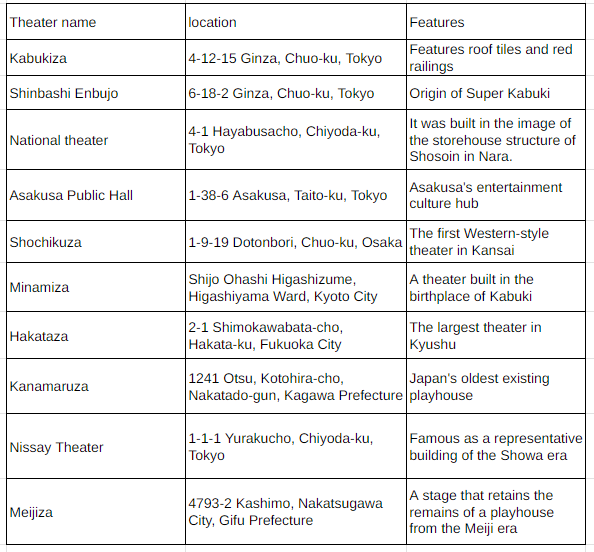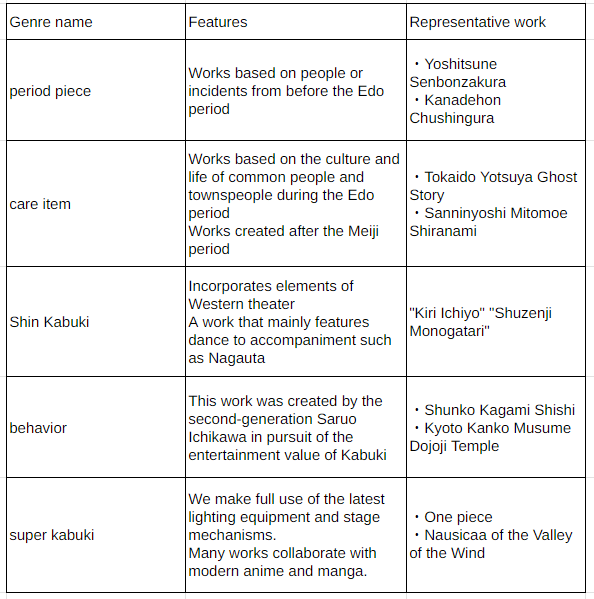
This article introduces ways to enjoy Kabuki for those who want to appreciate traditional Japanese performing arts. We will explain the roots of Kabuki, theaters where Kabuki can be seen, how to buy tickets, and other information you need to know when watching Kabuki. After reading this article, you should become interested in Kabuki. Please visit the theater and enjoy the beautiful costumes and the actors’ behavior.
■Before you learn how to enjoy Kabuki… here’s some basic knowledge!

To help you enjoy Kabuki, we will introduce an overview of what Kabuki is, where it is performed, and what genres there are. If you have some basic knowledge, watching Kabuki will become even more interesting.
What is Kabuki?
Kabuki is said to have started in 1603 when a woman called Okuni from Izumo performed the Kabuki Dance in Kyoto.
The name “Kabuki” comes from the word “kabuku”, which means “not bound by common sense”. As the name suggests, the roots of Kabuki are dancing in eccentric fashion. Kabuki, which evolved from this, has long been loved by people as a comprehensive art that combines acting, dance, and music. In November 2005, Kabuki was registered as a UNESCO Intangible Cultural Heritage.
Kabuki is performed almost every day from the 3rd to the 27th of every month at the Kabuki-za theater in Higashi Ginza, Tokyo. It is also performed irregularly at theaters around the country other than Kabukiza.
Where Kabuki is performed
The main theaters where Kabuki is performed are as follows.

Kabuki genre
There are five genres of Kabuki. Here, we will introduce the characteristics and representative works of each.

How to buy Kabuki tickets and what are the prices?
There are three types of Kabuki tickets:
・Advance ticket
・Tickets for today
・One act seat
There are three ways to purchase advance tickets and same-day tickets: online, by phone, and at the counter. Select the theater and performance you want to go to and purchase, but the purchasing method varies depending on the performance, so check the official website for detailed information. Advance tickets and same-day tickets cost 4,000 yen for the cheapest seats, B on the 3rd floor, and 20,000 yen for the most expensive seats on the 1st floor.
One-act tickets are tickets that allow you to choose your favorite performance from the daytime and evening performances.
Kabuki performances last approximately four hours, and may include one performance continuously, or multiple performances. Advance tickets and same-day tickets allow you to see all performances, but single-act seats are unique in that you can only watch one of them.
The price for a single act ticket is around 1,000 yen to 2,000 yen, and the price changes depending on the performance time. Single-act tickets can be purchased online or at the theater counter.
■Introducing tips on how to enjoy Kabuki!

There are many other things to see in Kabuki besides the performances. Learn how to enjoy Kabuki and enjoy Japan’s traditional performing arts to the fullest. Here we will introduce some points to enjoy Kabuki.
Take a closer look inside the theater
The theaters where Kabuki is performed pay special attention to the architecture, exterior, and interior. Please take this opportunity to take a close look at the beautiful artwork and decorations inside the theater.
For example, Kabuki Inari Shrine is enshrined in a corner of Kabukiza. This shrine was built to pray for the success of Kabuki performances and the safety of the audience, and is characterized by its bright vermilion color that stands out against the white exterior walls of the Kabuki-za Theater.
In addition, when you enter the main entrance, you will see a beautiful high-quality rug called “dantsu”. You will be moved by the gorgeous colors that are inspired by the “Sakucho Monyo” pattern depicted in the Phoenix Hall of Byodoin Temple in Kyoto.
In addition, the building has been constructed with great attention to detail. Please take a look around the grounds and enjoy the beauty of Japanese architecture.
Enjoy dining and shopping
Until the Kabuki performance starts, you can enjoy eating and shopping at the on-site shop. Kabukiza is lined with a variety of shops, including souvenir shops and restaurants.
The souvenir shop has a wide selection of Kabuki goods, and you’ll probably find items that can only be purchased here. They also sell cakes like castella cakes called “Ningyoyaki” and “Taiyaki,” so you can enjoy them freshly made.
Eating and drinking is allowed during the Kabuki theater. It would be a good idea to buy “Kabuki Gourmet” such as bento boxes and sweets to eat during breaks.
Other theaters also sell a variety of specialty items and goods, so be sure to check them out.
The highlight “Mie” is a must-see!
Don’t miss the highlight of Kabuki, Mie. Mite is an acting method used during important scenes in a play, in which the actors stand still in a beautiful and gorgeous pose when the characters are excited.
There are many different types of Mie, so it would be fun to check out the Mie of each work. Among them, the most famous one is “Nirami”. This is a method of making a glaring look without focusing the eyes, and can only be used by the family that inherited the Naritaya name.
It is said that the glare has a special effect on warding off evil spirits, so if you can see it, you may be blessed with good fortune.
■Manners when watching Kabuki

There are a few things to keep in mind when watching Kabuki. Please be careful if you do not follow the rules, as you will be a nuisance to those around you.
Don’t be late for the performance start time
Check the performance time and your seat in advance, and be sure to find your seat before the performance. It is smart to be seated at least 5 minutes before the performance starts.
It is OK to enter Kabuki in the middle, but if you enter late and wander around, it will be a nuisance to other customers. If you are unable to arrive in time for the performance due to unavoidable circumstances, please ask the staff to guide you to your seat.
Private language is prohibited during the performance.
Kabuki is meant to be enjoyed and watched, so it’s okay to laugh out loud at funny scenes. However, please refrain from speaking privately in other situations.
Also, the sound of plastic bags such as convenience store bags can be annoying. If you try to serve drinks in a quiet scene and make a rustling noise, people around you will be annoyed.
When watching Kabuki, it is good manners not to speak privately or make any noise.
Turn off your smartphone/tablet
Please turn off your smartphones and tablets during Kabuki performances. Please note that announcements will always be made before the performance. Even if you set it to silent mode, you can still hear the vibration, so be careful.
Filming and recording during the screening is strictly prohibited. I understand that you want to take pictures of the gorgeous costumes and glamorous stage, but please be patient and remember the details.
■Learn how to enjoy Kabuki and enjoy Japan’s traditional performing arts

You might think that it would be difficult for foreigners to appreciate Kabuki, but that is not the case. There are many ways to enjoy the festival, from the gorgeous stage and music to the actors’ performances and theater gourmet food.
If you go to see Kabuki on your trip to Japan, you’ll definitely be impressed by the depth of Japanese entertainment. Be sure to watch Kabuki and experience the fun of Japan’s traditional performing arts.
【O&A】
Q: How do I buy Kabuki tickets?
A: In addition to being available for purchase online, you can also purchase by phone or at the theater counter on the day of your purchase. Please note that “one-act seats” that allow you to watch only one performance are only sold at the theater on the day of the performance.
Q: Can I eat and drink inside the theater?
A During the performance, you can only drink drinks, but eating is prohibited. You can eat and drink during intermission, so you can enjoy bento boxes and sweets sold inside the theater.

